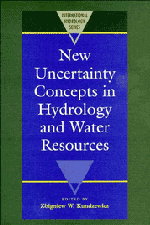Book contents
- Frontmatter
- Contents
- List of Authors
- Preface
- I INTRODUCTION
- II FACETS OF UNCERTAINTY
- III NOVEL APPROACHES TO UNCERTAINTY: FRACTALS, FUZZY SETS AND PATTERN RECOGNITION, NON-PARAMETRIC METHODS
- 1 Dispersion in stratified soils with fractal permeability distribution
- 2 Multifractals and rain
- 3 Is rain fractal?
- 4 Multifractal structure of rainfall occurrence in West Africa
- 5 Analysis of high-resolution rainfall data
- 6 Application of fuzzy theory to snowmelt runoff
- 7 On the value of fuzzy concepts in hydrology and water resources management
- 8 Application of neural network in groundwater remediation under conditions of uncertainty
- 9 Application of pattern recognition to rainfall–runoff analysis
- 10 Nonparametric estimation of multivariate density and nonparametric regression
- 11 Nonparametric approach to design flood estimation with pre-gauging data and information
- IV RANDOM FIELDS
- V TIME SERIES AND STOCHASTIC PROCESSES
- VI RISK, RELIABILITY AND RELATED CRITERIA
8 - Application of neural network in groundwater remediation under conditions of uncertainty
Published online by Cambridge University Press: 07 May 2010
- Frontmatter
- Contents
- List of Authors
- Preface
- I INTRODUCTION
- II FACETS OF UNCERTAINTY
- III NOVEL APPROACHES TO UNCERTAINTY: FRACTALS, FUZZY SETS AND PATTERN RECOGNITION, NON-PARAMETRIC METHODS
- 1 Dispersion in stratified soils with fractal permeability distribution
- 2 Multifractals and rain
- 3 Is rain fractal?
- 4 Multifractal structure of rainfall occurrence in West Africa
- 5 Analysis of high-resolution rainfall data
- 6 Application of fuzzy theory to snowmelt runoff
- 7 On the value of fuzzy concepts in hydrology and water resources management
- 8 Application of neural network in groundwater remediation under conditions of uncertainty
- 9 Application of pattern recognition to rainfall–runoff analysis
- 10 Nonparametric estimation of multivariate density and nonparametric regression
- 11 Nonparametric approach to design flood estimation with pre-gauging data and information
- IV RANDOM FIELDS
- V TIME SERIES AND STOCHASTIC PROCESSES
- VI RISK, RELIABILITY AND RELATED CRITERIA
Summary
ABSTRACT The design of groundwater contamination remediation based on hydraulic head gradient control method determines the locations of the pumping wells and their pumping rates. In a heterogeneous medium such a design will be sensitive to the spatial characteristics of the underlying geological parameters. The geological uncertainty is due to the heterogeneity of the hydraulic conductivity of the porous medium. Under conditions of uncertainty, incorporation of transmissivity fields with spatial characteristics that most influence the design will reduce the sensitivity of the design. A new class of artificial intelligence technique known as neural networks has been identified as appropriate for pattern association tasks. A neural network based screening tool is being developed to identify transmissivity fields with such spatial characteristics. The ongoing research embraces training a neural network to learn the association between transmissivity fields and their impact on the design, and using the trained network to classify randomly generated feasible transmissivity fields according to their level of impact on the design.
INTRODUCTION
Safe and effective designs for groundwater remediation is a topic that is currently gaining increased worldwide attention. There are many alternative techniques available for groundwater contaminant containment and restoration. The hydraulic gradient control for containment and removal of groundwater contamination is one of the techniques under investigation among the researchers in the field of groundwater management (Gorelick et al. (1984); Atwood & Gorelick (1985); Keely (1984); Colarullo (1984); Wagner & Gorelick (1987); Valocchi & Eheart (1987); Gorelick (1987); Wagner & Gorelick (1989); Morgan (1990)).
Information
- Type
- Chapter
- Information
- New Uncertainty Concepts in Hydrology and Water Resources , pp. 133 - 140Publisher: Cambridge University PressPrint publication year: 1995
Accessibility standard: Unknown
Why this information is here
This section outlines the accessibility features of this content - including support for screen readers, full keyboard navigation and high-contrast display options. This may not be relevant for you.Accessibility Information
- 8
- Cited by
